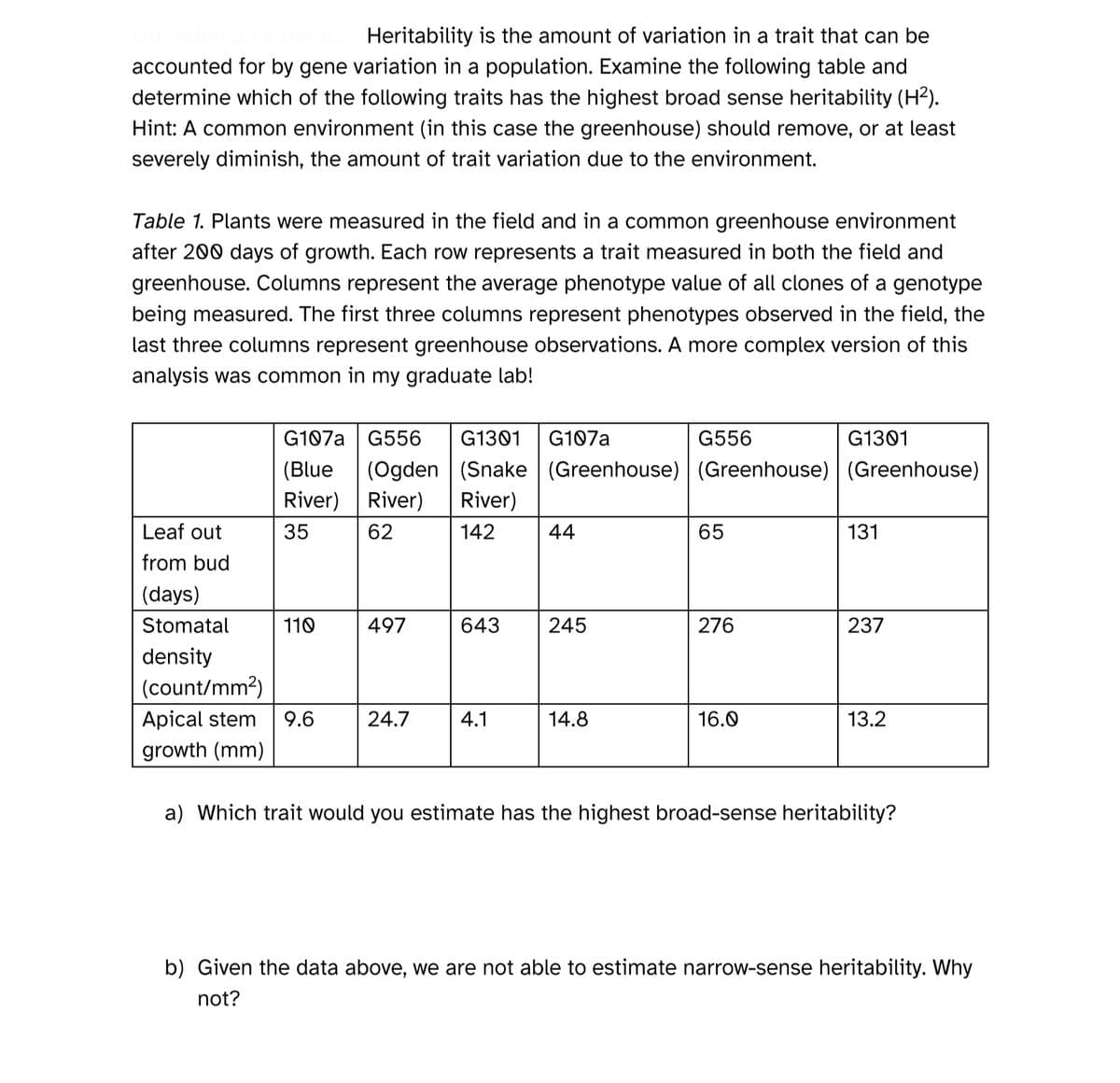Heritability is the amount of variation in a trait that can be accounted for by gene variation in a population. Examine the following table and determine which of the following traits has the highest broad sense heritability (H2). Hint: A common environment (in this case the greenhouse) should remove, or at least severely diminish, the amount of trait variation due to the environment. Table 1. Plants were measured in the field and in a common greenhouse environment after 200 days of growth. Each row represents a trait measured in both the field and greenhouse. Columns represent the average phenotype value of all clones of a genotype being measured. The first three columns represent phenotypes observed in the field, the last three columns represent greenhouse observations. A more complex version of this analysis was common in my graduate lab! G107a G556 G1301 G107a G556 G1301 (Blue (Ogden (Snake (Greenhouse) (Greenhouse) (Greenhouse) River) Leaf out 35 River) 62 River) 142 44 65 131 from bud (days) Stomatal 110 497 643 245 276 237 density (count/mm²) Apical stem growth (mm) 9.6 24.7 4.1 14.8 16.0 13.2 a) Which trait would you estimate has the highest broad-sense heritability? b) Given the data above, we are not able to estimate narrow-sense heritability. Why not?
Heritability is the amount of variation in a trait that can be accounted for by gene variation in a population. Examine the following table and determine which of the following traits has the highest broad sense heritability (H2). Hint: A common environment (in this case the greenhouse) should remove, or at least severely diminish, the amount of trait variation due to the environment. Table 1. Plants were measured in the field and in a common greenhouse environment after 200 days of growth. Each row represents a trait measured in both the field and greenhouse. Columns represent the average phenotype value of all clones of a genotype being measured. The first three columns represent phenotypes observed in the field, the last three columns represent greenhouse observations. A more complex version of this analysis was common in my graduate lab! G107a G556 G1301 G107a G556 G1301 (Blue (Ogden (Snake (Greenhouse) (Greenhouse) (Greenhouse) River) Leaf out 35 River) 62 River) 142 44 65 131 from bud (days) Stomatal 110 497 643 245 276 237 density (count/mm²) Apical stem growth (mm) 9.6 24.7 4.1 14.8 16.0 13.2 a) Which trait would you estimate has the highest broad-sense heritability? b) Given the data above, we are not able to estimate narrow-sense heritability. Why not?
Human Heredity: Principles and Issues (MindTap Course List)
11th Edition
ISBN:9781305251052
Author:Michael Cummings
Publisher:Michael Cummings
Chapter5: The Inheritance Of Complex Traits
Section: Chapter Questions
Problem 13QP: If there is no genetic variation within a population for a given trait, what is the heritability for...
Related questions
Question
100%

Transcribed Image Text:Heritability is the amount of variation in a trait that can be
accounted for by gene variation in a population. Examine the following table and
determine which of the following traits has the highest broad sense heritability (H2).
Hint: A common environment (in this case the greenhouse) should remove, or at least
severely diminish, the amount of trait variation due to the environment.
Table 1. Plants were measured in the field and in a common greenhouse environment
after 200 days of growth. Each row represents a trait measured in both the field and
greenhouse. Columns represent the average phenotype value of all clones of a genotype
being measured. The first three columns represent phenotypes observed in the field, the
last three columns represent greenhouse observations. A more complex version of this
analysis was common in my graduate lab!
G107a G556 G1301 G107a
G556
G1301
(Blue
(Ogden (Snake (Greenhouse) (Greenhouse) (Greenhouse)
River)
Leaf out
35
River)
62
River)
142
44
65
131
from bud
(days)
Stomatal
110
497
643
245
276
237
density
(count/mm²)
Apical stem
9.6
24.7
4.1
14.8
16.0
13.2
growth (mm)
a) Which trait would you estimate has the highest broad-sense heritability?
b) Given the data above, we are not able to estimate narrow-sense heritability. Why
not?
Expert Solution
This question has been solved!
Explore an expertly crafted, step-by-step solution for a thorough understanding of key concepts.
This is a popular solution!
Trending now
This is a popular solution!
Step by step
Solved in 3 steps

Knowledge Booster
Learn more about
Need a deep-dive on the concept behind this application? Look no further. Learn more about this topic, biology and related others by exploring similar questions and additional content below.Recommended textbooks for you

Human Heredity: Principles and Issues (MindTap Co…
Biology
ISBN:
9781305251052
Author:
Michael Cummings
Publisher:
Cengage Learning

Human Heredity: Principles and Issues (MindTap Co…
Biology
ISBN:
9781305251052
Author:
Michael Cummings
Publisher:
Cengage Learning